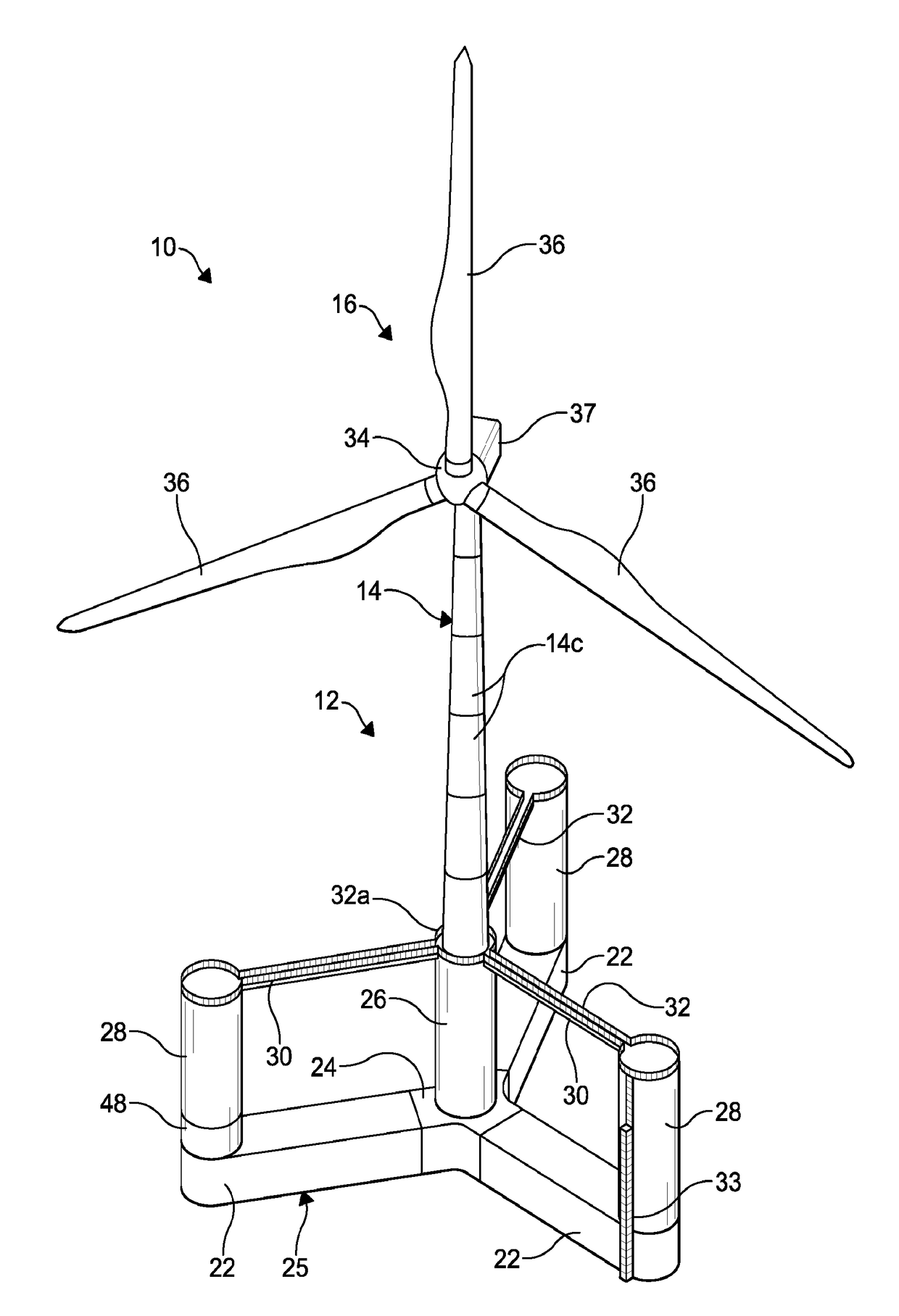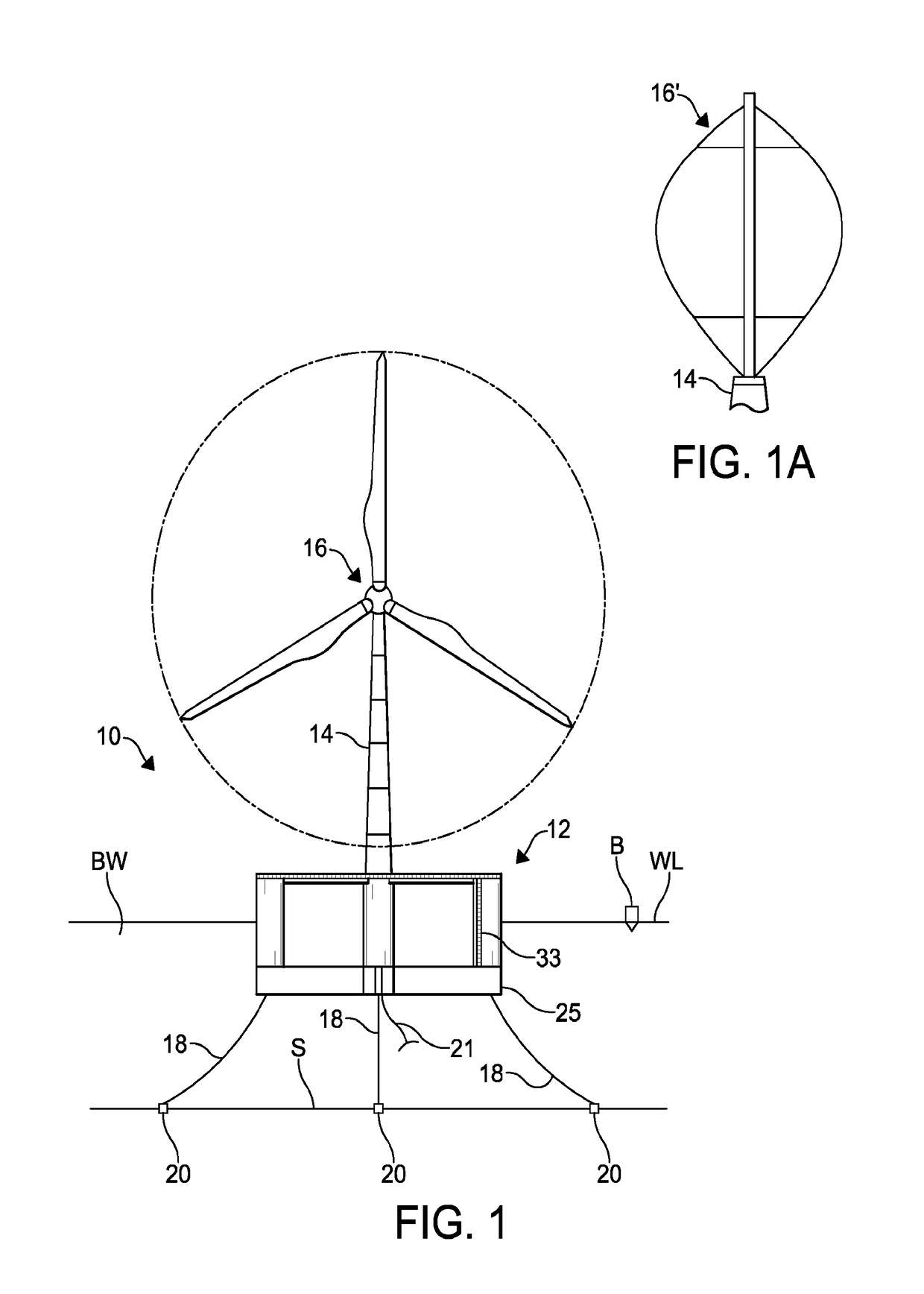Method of construction, assembly, and launch of a floating wind turbine platform
a technology of wind turbines and platforms, which is applied in the field of wind turbine platforms, can solve the problems of unsatisfactory aesthetics, unsatisfactory wind turbines, and inability to achieve the optimal flow of air on land
- Summary
- Abstract
- Description
- Claims
- Application Information
AI Technical Summary
Benefits of technology
Problems solved by technology
Method used
Image
Examples
first embodiment
[0032]Referring to the drawings, particularly to FIG. 1, a floating wind turbine system or platform 10 is shown anchored to a bed of a body of water BW. The floating wind turbine platform is representative of a wind turbine platform that has been constructed and assembled in accordance with the improved method of this invention. In the illustrated embodiment, the floating wind turbine platform 10 is shown anchored to the seabed S. It will be understood that the seabed may be the bed of any body of water in which the floating wind turbine platform 10 will be placed into operation.
[0033]The illustrated floating wind turbine platform 10 includes a foundation or hull 12 that supports a tower 14, described below in detail. The tower 14 supports a wind turbine 16. The foundation is semi-submersible, and is structured and configured to float, semi-submerged, in a body of water. Accordingly, a portion of the hull 12 will be above water when the hull 12 is floating in the water. As shown, a ...
second embodiment
[0050]the hull is shown at 70 in FIG. 4. As shown in FIG. 4, the hull 70 includes a base 72, also shown in FIG. 5, comprising three buoyant bottom beams 74 that extend radially outwardly from a keystone 76. A center column 78 is mounted to the keystone 76, and three outer columns 80 are mounted at or near the distal ends of the bottom beams 74. Although three buoyant bottom beams 74 are shown in FIG. 4, it will be understood that the hull 70 may include more than three buoyant bottom beams 74.
[0051]As described in detail below, the bottom beams 74 may be formed from a plurality of beam sections 82 and a column base section 84, upon which the outer columns 80 are mounted. The bottom beams 74 may be formed from any desired number of beam sections 82, such as the six beam sections 82 illustrated in FIG. 4, less than six beam sections 82, or more than six beam sections 82. If desired, the keystone 76 may also be formed in any desired number of sections (not shown).
[0052]As also describe...
third embodiment
[0088]Referring now to FIG. 15, a method of constructing, assembling, and launching the floating wind turbine platform 10, or a portion thereof, is shown at M3.
[0089]As shown in FIG. 15, the construction and assembly of bottom beams 74 and wings 75 in one or more construction and assembly areas A3 on shore near a body of water BW having a shoreline SL. As used herein, a wing 75 is defined as a bottom beam 74 with the keystone 76 attached thereto.
[0090]The construction and assembly areas A3 may be located at any desired location and is connected to a method of moving the bottom beams 74 and wings 75 from and through the construction and assembly areas A3 and to the shoreline SL. As shown in FIG. 15, the shoreline SL may be defined by the dock D. The bottom beams 74 and wings 75 may be assembled on a platform (not shown) configured to move on a system of longitudinally extending rails, schematically illustrated at 142. The rails 142 extend substantially parallel with the shoreline SL ...
PUM
 Login to View More
Login to View More Abstract
Description
Claims
Application Information
 Login to View More
Login to View More - R&D
- Intellectual Property
- Life Sciences
- Materials
- Tech Scout
- Unparalleled Data Quality
- Higher Quality Content
- 60% Fewer Hallucinations
Browse by: Latest US Patents, China's latest patents, Technical Efficacy Thesaurus, Application Domain, Technology Topic, Popular Technical Reports.
© 2025 PatSnap. All rights reserved.Legal|Privacy policy|Modern Slavery Act Transparency Statement|Sitemap|About US| Contact US: help@patsnap.com



